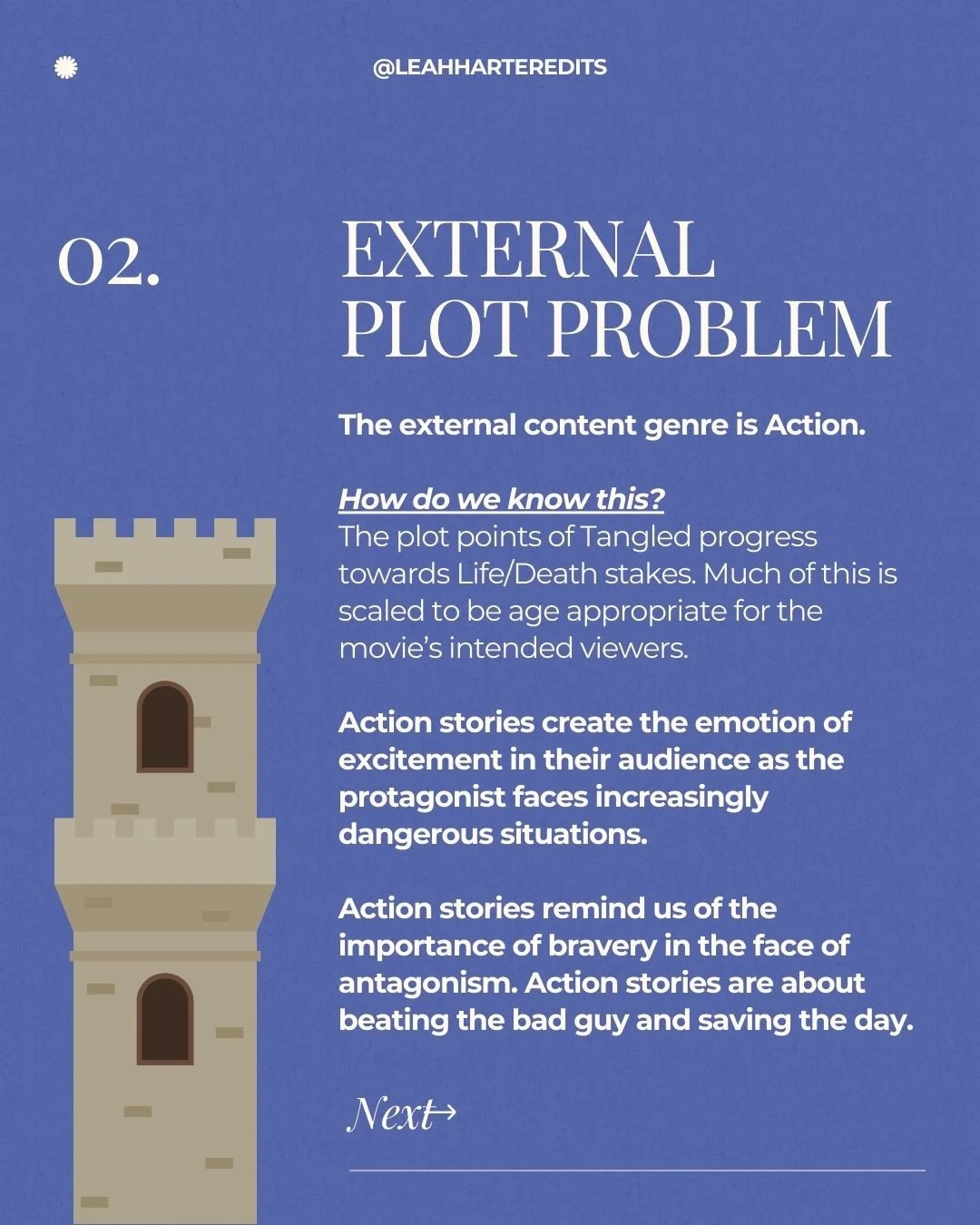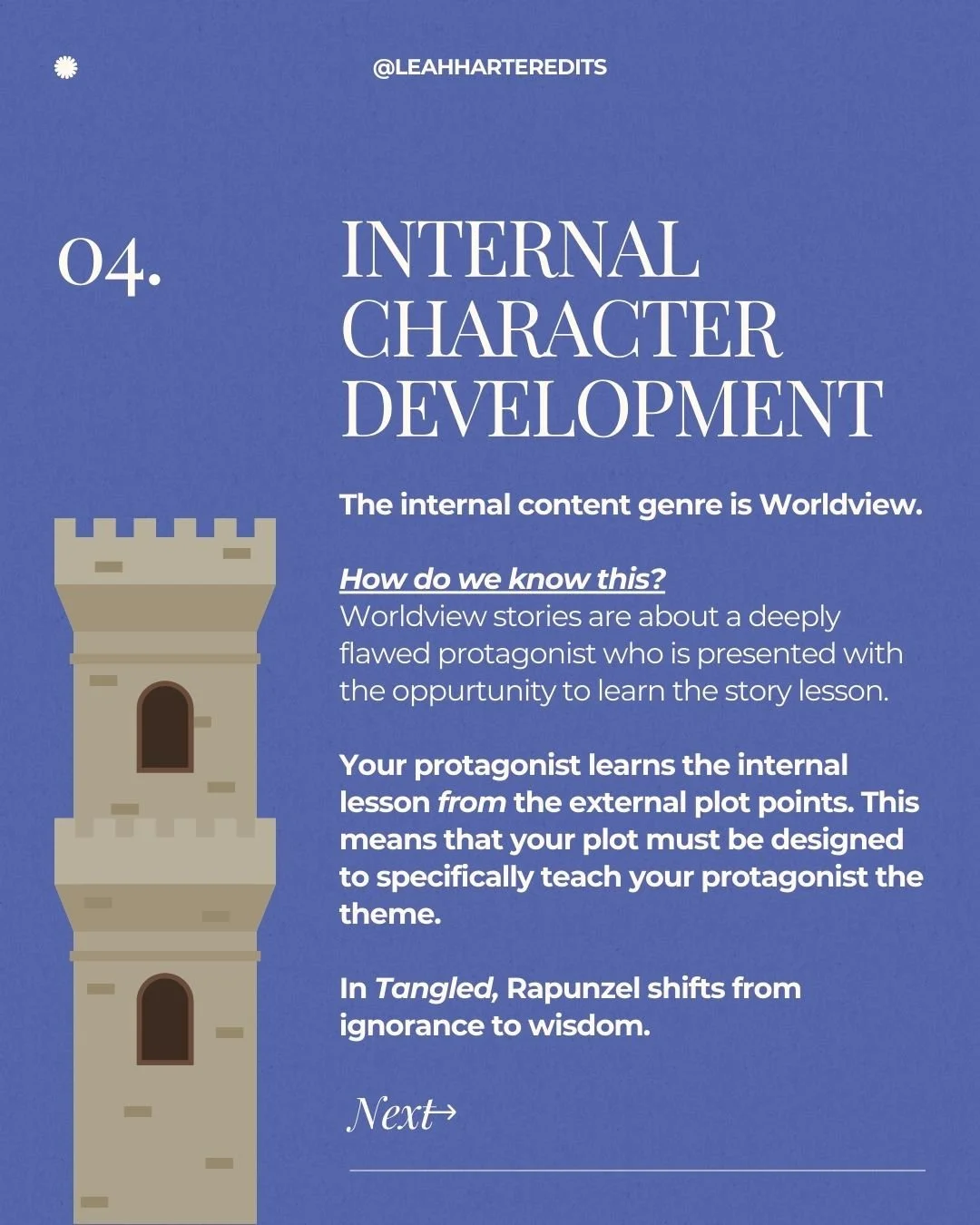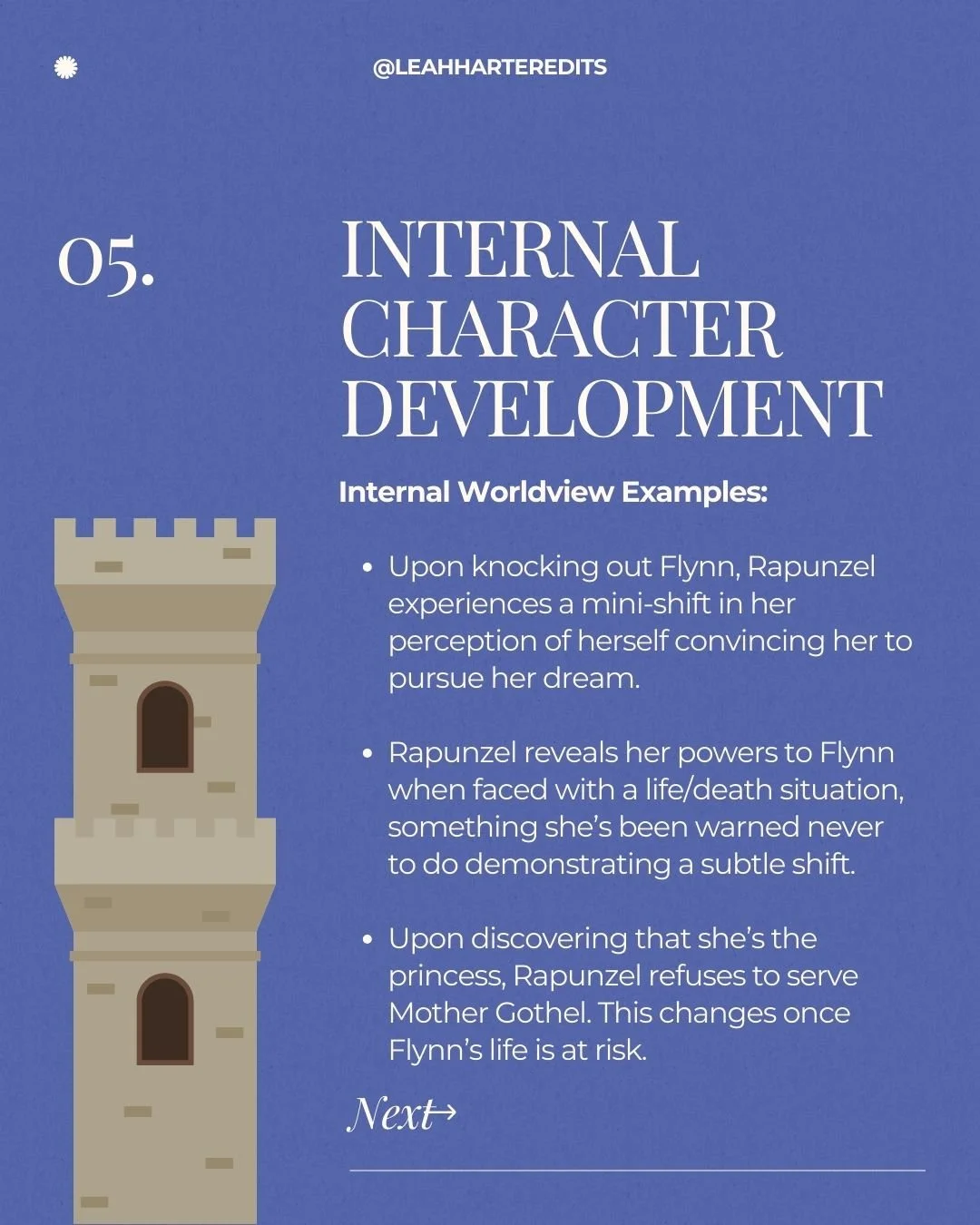Romantasy Genre Analysis: Using Disney's Tangled
You're likely not leveraging genre to captivate readers and craft an unforgettable story. Many writers aren't using content genres effectively due to a lack of knowledge regarding this tool. But content genres are a resource that all writers can use to elevate their story before they put words on the page.
In today's blog post, I am going to analyze the content genre of Disney's Tangled to give you an example of how you can write a story that readers are obsessed with.
Content genre is the type of story that you are telling. Every content genre has required scenes and genre conventions. Using genre conventions helps writers use what readers already know about stories to their advantage. Today's lesson will focus less on definitions, but if you need a content genre crash course, check out this blog post.
In Tangled, a naïve young woman named Rapunzel is being held captive in a tower by a woman she believes to be her mother. Her life changes when her love interest, Flynn Rider, accidentally finds himself in her tower. She barters with Flynn to take her on a journey to see the floating lights, her long time wish. Flynn agrees because Rapunzel has the tiara that he is intent on stealing. Rapunzel's journey is filled with unimaginable challenges and danger until she witnesses the floating lights. Now that she's achieved her dream: will she return to her tower to live out her life or search for a new dream?
Why Tangled?
Perhaps you're curious why I'm using a Disney film to illustrate my point.
That's a good question. I am using Tangled for three reasons:
Disney films are usually around 90 minutes long; therefore, if you're unfamiliar with the movie and want to understand this blog, you won't need to spend eight hours reading a book. You're welcome!
The content genres of Tangled mirror what I see in most Romantasy novels. Since these are the same, I can use this movie as a tool to explain to you how the different types of genre interact with each other.
I don't like spoilers and this movie has been out for over a decade, increasing the likelihood that you have already seen it.
Now that we got that out of the way, let's dive into the external content genre or the plot of the movie.
External Plot Problem: Stakes & Consequences
The external content genre determines what is at stake for your protagonist. In this case, Tangled is an Action Story.
How do we know this? Well, the stakes in Rapunzel can be summarized as a conflict of life vs. death. This has to be brought down to an age appropriate level given the intended audience. Rather than facing immediate threat of death, Rapunzel faces dangerous situations that could injure or harm her.
Here are some examples of action plot points in Tangled:
Action Story Plot Point Examples:
Mother Gothel warns Rapunzel of the dangers of the real world in “Mother Knows Best.”
Rapunzel hits Flynn with a frying pan.
Rapunzel and Flynn escape from the palace guards and find themselves trapped in a cavern filling with water.
Mother Gothel saves Rapunzel from thugs that mean to do her harm.
Mother Gothel stabs Flynn forcing Rapunzel to make a deal with her.
Disney makes a promise to the reader at the beginning of the movie that this will be an action story by showing us Mother Gothel cutting Rapunzel's hair and then kidnapping her. It's implied that she only takes the baby because she realizes that killing her will remove the magic she desperately craves.
Action stories inspire the emotion of excitement in the reader as the protagonist faces situations where they could experience harm or danger. For this reason, it's a common choice for those writing romantasy or romantic fantasy novels. Some titles you might recognize from this external content genre include A Court of Thornes and Roses by Sarah J. Maas, The Wren in the Holly Library by K. A. Linde and Fourth Wing by Rebecca Yarros.
In action stories, you might think that the worst thing that can happen to a character is dying. However, the protagonist of this story can often face a "Fate worse than Death," which is an event that they would rather die than experience. This story element is a tool in action stories to show your protagonist's deepest internal values. These are the core beliefs that they will protect to the highest order and they develop your protagonist into a nuanced and complex being. For Rapunzel, this situation comes when Mother Gothel attempts to kill Flynn Rider. Rapunzel would rather subject herself to a lifetime of servitude than experience this. For this reason, she offers to go with her villain, rather than suffer Flynn's death and this moment indicates to the reader that Rapunzel has changed. Protecting the man she loves becomes more important than saving herself from the fate of serving Mother Gothel for the rest of her life.
Internal Character Arc: Rapunzel has a Dream
The internal content genre is Worldview.
Worldview stories are about deeply flawed protagonists that experience life-altering change. This is captured through a shift in their internal world by unlearning or learning a lesson about themselves or the world around them. In writing, we call this character development.
For Rapunzel, the internal shift in her inner world is from ignorance to wisdom as she learns the truth about herself. She starts the story unaware of her status as a princess and naïve to the realities of the world, both good and bad. As she begins to explore, she gains knowledge and confidence as she pursues her goal of seeing the lights. Each plot point causes her to question what she believed before about her role in the world and what she wants for herself.
Internal Worldview Examples:
Upon knocking out Flynn, Rapunzel experiences a mini-shift in her perception of herself convincing her to pursue her dream.
Rapunzel reveals her powers to Flynn when faced with a life/death situation, something she’s been warned never to do demonstrating a subtle shift.
Upon discovering that she’s the princess, Rapunzel refuses to serve Mother Gothel. This changes once Flynn’s life is at risk.
It's key that your external plot points influence or direct the shift in your protagonist's internal world. As Rapunzel faces external threats such as ruffians, palace guards, and near-death by drowning, the reader understands that these events are changing her internal world in a specific way. She grows more confident and wiser with each step along her journey. We see this in her conversation with Flynn before they see the lanterns. Rapunzel wonders what she will do if it's not everything she hoped it would be. Flynn tells her that she can find a new dream demonstrating this change in her to be life-altering. She can never go back to where she was before because of the new knowledge she's gained along the way.
With my clients, I often compare this to stepping stones. You don't want to show drastic change in your protagonist from one chapter to the next instead. Treat each plot point as a tiny baby step towards life-altering internal change.
Romance Subplot: Everyone loves a Happy Ending
Whether you're thinking about Rapunzel or your romance fantasy novel, you might consider: what's the role of romance in the narrative? This is a frequent debate amongst fans of this genre. Is the romance the primary external content genre or a subplot?
In most cases, the action external content genre reigns supreme with few exceptions. One way to determine this is to consider how much page time the romance gets compared to the action. An easy test is to ask: if I removed the romance plotline from my story, would it still make sense? If the answer is no, then your primary genre is likely a love story. In love stories or buddy love in the Save the Cat! terminology, the relationship between two characters propels the protagonist's internal shift, not the action sequences. An example of a fantasy novel with a love story external content genre is Bride by Ali Hazelwood.
With Rapunzel, it's clear that the action story takes center stage. If Rapunzel and Flynn remained friends throughout the novel, Rapunzel would still have the same shift in her worldview. It is her experience of danger and adventure that drives her change, not her romance with Flynn.
Story Question: One-Sentence Pitch
If you haven't read my blog post about the one-sentence pitch, you can find it here. I use the following template to summarize the Big Question of the story:
Will [protagonist] learn [theme] and [achieve their goal] or will they [cannot learn the theme] and [stakes if they fail]?
Let's apply this to Tangled.
Will Rapunzel learn to trust her own strength and achieve her freedom, or will she remain blinded by manipulation and live as a prisoner forever?
Rapunzel's path from innocent girl to self-discovery as the lost princess is fraught with peril, mystery, and wonder. Her adventure teaches viewers about what it means to be brave as she defeats her antagonist and saves her love interest. These are all hallmarks of the romantasy genre. Using this classic Disney tale as an example, the relationship between the external and internal content genres becomes clear. Your protagonist's shift in worldview is defined by the moments on the page that change how they view themselves or their world.
That’s all for now! For more writing tips and tricks, feel free to reach out to me or learn more on my Instagram below:






